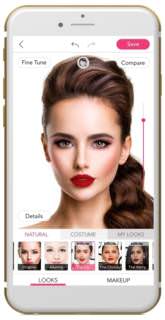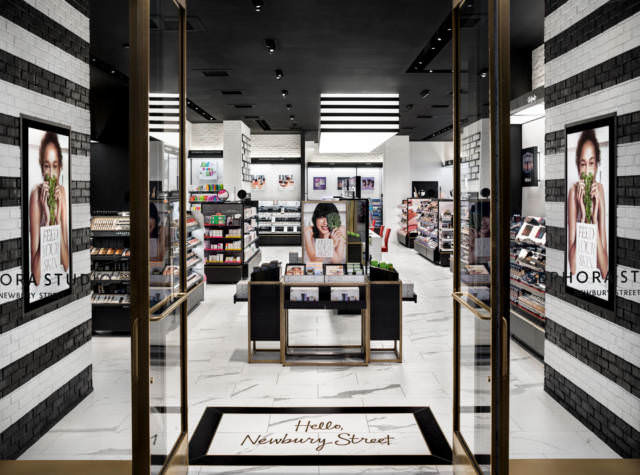Beauty brands are merging the real world with the digital one at an increasingly higher rate, and activations through emerging tech such as augmented reality are turning into pivotal players in helping legacy makeup brands reach millennials and Gen Z.
Looking for a new concealer, foundation or shade of lipstick? Rather than trudging into a brick-and-mortar and making it a half-day event to find a new product that’s going to add more color to your life than an Instagram filter, tech-savvy consumers are taking to mobile for beauty on their own terms.
As makeup mavens take to tech and mobile, marketers are looking to tap into the modern millennial mindshare with their omnichannel strategies.
“Today’s consumers expect their shopping experience to be fun, effortless and tailor-made to meet their momentary aspirations, moods and desires—wherever they are,” Esohe Omoruyi, senior vice president of global open innovation and digital services for L’Oréal, told AListDaily. “Services are an important part of this modern consumer journey—and it’s especially true for beauty, where personalization, advice and the possibility to try products is key.”

Earlier this summer, L’Oréal integrated its worldwide makeup brands and collections into YouCam Makeup, an AR beauty app. The move builds on the 2014 launch of their own virtual makeup app, Makeup Genius from L’Oréal Paris, which has been downloaded 20 million times worldwide.
Omoruyi says L’Oréal’s omnichannel approach opens opportunities to develop stronger relationships with consumers at every touchpoint, learn more about their aspirations and grow their business both online and offline.
L’Oréal is the number one beauty brand in the US and accounts for roughly 19 percent of America’s $56.8 billion dollar industry, according to the Statistic Brain Research Institute.
“This strategy allows integrating L’Oréal products and brands into the daily routine of our consumers—it can be a chatbot helping you selecting a beauty gift for your friend, a hairbrush that can recommend products based on the texture of your hair, a virtual makeup experience or a personalized foundation tailor-made for you at our counter,” Omoruyi says. “Technologies like machine learning, artificial intelligence and augmented reality allow us to be where consumers expect us to be—online and offline—and to offer them personalized services which enhance their daily beauty experience.”
True-to-life, virtual try-ons offer convenience and eliminate the mess of testing physical products in stores. To further find out how millennials interact with virtual events as part of their digital lifestyle, L’Oréal went to the Cannes Film Festival with YouCam earlier this year to bring the 64 best film-inspired looks. They paired the activation with livestreamed tutorials.
“These new kinds of highly interactive events are only possible because of the most advanced AR technology,” Alice H. Chang, CEO of Perfect Corp., the parent company of YouCam Makeup, told AListDaily. “Engagement in this type of content is dramatically higher than any normal post or video coverage from Cannes, as users feel more personally involved by trying red carpet looks on their own selfies. We’re encouraged by how much users enjoyed participating.”
Chang says AR takes the convenience and ease of online shopping—quick searching, easily narrowing down product choices—and brings it to the experiential physical space—actually touching and feeling the product.
“AR connects the dots to create a very unique experience that cannot be replaced by any other channel,” she says. “Try-before-you-buy gives customers greater confidence in the purchase decisions. The impact of AR try-outs on cosmetic sales is real.”
According to an independent consumer report conducted by YouCam in July, mobile AR try-ons drive two times more conversions for beauty products, and Gen Z users are 10 times more likely to purchase beauty products after using YouCam Makeup.
“With 73 percent of today’s customers shopping both online and offline, we know there are benefits to shopping in each channel,” Chang says. “Retailers can take advantage of AR technologies to combine what consumers love best about the physical world with the endless possibilities of the digital world. AR and 3D technologies have the potential to bring the best of the digital world into the physical retailer.”
Retailers like Sephora are trying to bridge the gap between digital and physical commerce by driving personal connections and enhancing the consumer shopping experience.

Sephora Studio, a digital-and-mobile-first, small-format concept store launched last month, and it is all about high-tech beauty upgrades. The flagship Boston location is designed to be a larger part of the upmarket brand’s omnichannel strategy.
Jennifer Halpainy, Sephora Studio’s store director, told AListDaily that the studio supplements its existing store strategy by enhancing the shopping experience.
“The studio is uniquely differentiated from the rest of the fleet because of its emphasis on driving personal connections,” Halpainy says. “This is fostered not only through the small format and easy access clients have to the beauty advisors, but also through the new digital features that will allow for customized recommendations—both self-guided by the client using the many digital tools and with the help of the pros.”
One of the intended store-stopping showcases Sephora is banking on is the Digital Makeover Guide, which captures a person’s product, application and look preferences from a makeover.
“Sephora is continuously refining in-store, online and mobile experiences to ensure they are offering something that does not exist anywhere else for the consumer,” Halpainy says. “The studio is an example of that. The design re-imagines what their store looks like, where it fits into their omnichannel ecosystem and the experience they’re offering clients. We do not approach digital for the sake of adding new, cool technology. We use it to help the client. The studio integrates a variety of digital tools to optimize client experiences before, during and after their store visit.”
In addition to the physical store, Sephora is looking to secure consumer affection socially with the launch of Beauty Insider Community, a loyalty member-only mobile and online platform that launched last month to drive a deeper connection between their beauty insiders. The digital endeavor is designed to serve as a unified communal destination for the brand’s staunch supporters.
Bringing consumers true value means continuously improving the customer experience, Chang says.
“The virtual experience democratizes beauty, making brand products available for all consumers to experience products instantly,” Chang says. “It should be as effortless as looking in the mirror or taking a picture.”

